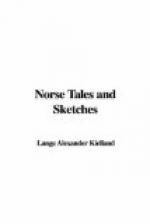But even if the flock flies past, there is always uneasiness and noise when they come over Aarre Water. The ranks break, for a time the whole becomes a confused mass, while they all scream and quack at the same time.
Only slowly do they form again and fly southward in long lines, until they shrink to thinner and thinner threads in the gray autumn sky, and their last sound follows them upon the north wind.
Then I always believe that there has been a debate as to whether they should take a little rest down on Aarre Water. There are certainly many old ones who know the place again, and plenty of the young are tender-winged, and would fain sit on the water and dawdle away a half-day’s time.
But when it is eventually resolved to fly on without stopping, and the lines again begin to arrange themselves, it has become clear to me that each seeks his own place in the ranks slanting outwards behind the leaders, so that by this means he may be conducted along with the train without being under the necessity of troubling about the way.
If these large, heavy birds were to fly in a cluster for weeks, day and night, separation and confusion would be inevitable. They would get in each other’s way every minute with their heavy wings, there would be such a noise that the leader’s voice could not be distinguished, and it would be impossible to keep an eye upon him after dark. Besides, over half the number are young birds, who are undertaking this tremendous journey for the first time, and who naturally, at Aarre Water, begin to ask if it be the Nile that they see. Time would be lost, the flock would be broken up, and all the young would perish on the journey, if there were not, in the very disposition of the ranks, something of the beautiful reasoning thought binding them together.
Let us now consider the first bird, who leads the flock—presumably an old experienced gander. He feels an impulse towards the south, but he undoubtedly bends his neck and looks down for known marks in the landscape. That is why the great flocks of geese follow our coast-line southward until the land is lost to view.
But the birds do not look straight forward in the direction of their bills: they look to both sides. Therefore, the bird next to the leader does not follow right behind him in the ‘cloven’ air, but flies nearly alongside, so that it has the leader in a direct line with its right or left eye at a distance of about two wing-flaps.
And the next bird does the same, and the next; each keeps at the same distance from its fore-bird.
And what each bird sees of its fore-bird are the very whitest feathers of the whole goose, under the wings and towards the tail, and this, in dark nights, is of great assistance to the tired, half-sleeping creatures.
Thus each, except the pilot himself, has a fore-bird’s white body in a line with one eye, and more they do not need to trouble about. They can put all their strength into the monotonous work of wing-flapping, as long as they merely keep the one eye half open and see that they have the fore-bird in his place. Thus they know that all is in order, that they are in connection with the train, and with him at the head who knows the way.




